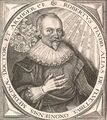Pierre Gassendi (nonfiction): Difference between revisions
(Created page with "thumb|Pierre Gassendi.'''Pierre Gassendi''' (also Pierre Gassend, Petrus Gassendi; 22 January 1592 – 24 October 1655) was a French philosopher,...") |
No edit summary |
||
| (5 intermediate revisions by the same user not shown) | |||
| Line 7: | Line 7: | ||
The lunar crater Gassendi is named after him. | The lunar crater Gassendi is named after him. | ||
He clashed with his contemporary [[Descartes (nonfiction)|Descartes]] on the possibility of certain knowledge. His best known intellectual project attempted to reconcile Epicurean atomism with Christianity. | He clashed with his contemporary [[René Descartes (nonfiction)|Descartes]] on the possibility of certain knowledge. His best known intellectual project attempted to reconcile Epicurean atomism with Christianity. | ||
He wrote numerous philosophical works, and some of the positions he worked out are considered significant, finding a way between skepticism and dogmatism. | He wrote numerous philosophical works, and some of the positions he worked out are considered significant, finding a way between skepticism and dogmatism. | ||
He wrote against the magical animism of [[Robert Fludd (nonfiction)|Robert Fludd]], and [[Judicial astrology (nonfiction)|judicial astrology]]. | |||
Richard Popkin indicates that Gassendi was one of the first thinkers to formulate the modern "scientific outlook", of moderated skepticism and empiricism. | Richard Popkin indicates that Gassendi was one of the first thinkers to formulate the modern "scientific outlook", of moderated skepticism and empiricism. | ||
| Line 16: | Line 18: | ||
<gallery> | <gallery> | ||
File:René Descartes.jpg|link=René Descartes (nonfiction)|[[René Descartes (nonfiction)|René Descartes]] and Pierre Gassendi clash over the possibility of certain knowledge. | |||
File:Robert Fludd.jpg|link=Robert Fludd (nonfiction)|[[Robert Fludd (nonfiction)|Robert Fludd]]'s theories are "magical animism", says Gassendi. | |||
</gallery> | </gallery> | ||
| Line 22: | Line 26: | ||
* [[Crimes against mathematical constants]] | * [[Crimes against mathematical constants]] | ||
* [[Gnomon algorithm]] | * [[Gnomon algorithm]] | ||
* [[Gnomon Chronicles]] | |||
* [[Mathematician]] | |||
* [[Mathematics]] | |||
== Nonfiction cross-reference == | == Nonfiction cross-reference == | ||
* [[René Descartes (nonfiction)]] | |||
* [[Robert Fludd (nonfiction)]] | |||
* [[Judicial astrology (nonfiction)]] | |||
* [[Mathematician (nonfiction)]] | |||
* [[Mathematics (nonfiction)]] | * [[Mathematics (nonfiction)]] | ||
* [[Vincenzo Viviani (nonfiction)]] - later performed similar experiments | |||
External links: | External links: | ||
Latest revision as of 21:52, 26 January 2019
Pierre Gassendi (also Pierre Gassend, Petrus Gassendi; 22 January 1592 – 24 October 1655) was a French philosopher, priest, scientist, astronomer, and mathematician.
While he held a church position in south-east France, he also spent much time in Paris, where he was a leader of a group of free-thinking intellectuals.
He was also an active observational scientist, publishing the first data on the transit of Mercury in 1631.
The lunar crater Gassendi is named after him.
He clashed with his contemporary Descartes on the possibility of certain knowledge. His best known intellectual project attempted to reconcile Epicurean atomism with Christianity.
He wrote numerous philosophical works, and some of the positions he worked out are considered significant, finding a way between skepticism and dogmatism.
He wrote against the magical animism of Robert Fludd, and judicial astrology.
Richard Popkin indicates that Gassendi was one of the first thinkers to formulate the modern "scientific outlook", of moderated skepticism and empiricism.
In the News
René Descartes and Pierre Gassendi clash over the possibility of certain knowledge.
Robert Fludd's theories are "magical animism", says Gassendi.
Fiction cross-reference
Nonfiction cross-reference
- René Descartes (nonfiction)
- Robert Fludd (nonfiction)
- Judicial astrology (nonfiction)
- Mathematician (nonfiction)
- Mathematics (nonfiction)
- Vincenzo Viviani (nonfiction) - later performed similar experiments
External links:
- Pierre Gassendi @ Wikipedia


